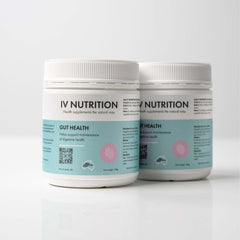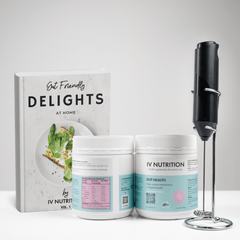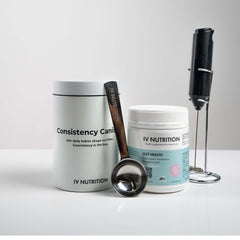An unhealthy gut doesn’t just cause digestive discomfort—it can quietly sabotage your immune system, energy levels, skin health, and even mental clarity. Bloating, irregular bowel movements, food intolerances, fatigue, and brain fog are just a few signs your gut microbiome may be out of balance.
The good news? The gut has an extraordinary ability to regenerate and heal—when supported with the right nutrients, lifestyle, and care.
In this clinically grounded, science-backed guide, we’ll walk through how to safely and effectively flush out an unhealthy gut, restore microbial balance, and promote long-term digestive health.
Table of Contents
-
What Does It Mean to Have an “Unhealthy Gut”?
-
Symptoms and Red Flags of Gut Imbalance
-
What Causes Gut Dysfunction in the First Place?
-
The Science Behind “Flushing Out” Your Gut
-
Step-by-Step Protocol to Reset Your Gut Health
-
The Role of Prebiotic Fiber in Gut Detox
-
Spotlight: Virgin-Manufactured Sugarcane Prebiotic Fiber
-
Foods to Eat and Avoid During a Gut Reset
-
How Long Does It Take to Repair the Gut?
-
Supporting Long-Term Gut Health: Lifestyle Habits That Matter
-
Conclusion: Give Your Gut the Clean Slate It Needs
1. What Does It Mean to Have an “Unhealthy Gut”?
The term “unhealthy gut” typically refers to a disrupted gastrointestinal environment. This could mean:
-
An imbalance in your gut bacteria (dysbiosis)
-
Compromised gut lining or "leaky gut"
-
Chronic inflammation in the GI tract
-
Poor digestion or nutrient malabsorption
When these issues go unresolved, they affect more than your digestive system. Over time, gut dysfunction contributes to fatigue, weight gain, immune imbalances, and even mental health struggles due to the gut-brain axis.
2. Symptoms and Red Flags of Gut Imbalance
You don’t need a lab test to know something’s off with your gut. Common symptoms include:
-
Chronic bloating or gas
-
Constipation or diarrhea
-
Brain fog and mood swings
-
Sugar cravings or food intolerances
-
Poor skin quality (acne, eczema)
-
Fatigue even after adequate sleep
-
Frequent colds or low immunity
These signs are your body’s way of saying your digestive ecosystem needs a reset.
3. What Causes Gut Dysfunction in the First Place?
Modern life isn’t kind to the microbiome. Several factors disrupt gut health, including:
-
Antibiotic overuse
-
Processed foods high in sugar and refined oils
-
Low fiber diets
-
Excess alcohol or caffeine
-
Chronic stress
-
Poor sleep habits
-
Lack of microbial diversity
Over time, these habits starve beneficial bacteria and allow harmful species to flourish—creating inflammation, permeability in the gut lining, and a compromised immune response.
4. The Science Behind “Flushing Out” Your Gut
Let’s clarify something important: flushing out your gut is not about harsh cleanses, laxatives, or starvation detoxes.
A real, science-supported gut reset involves:
-
Gently eliminating inflammatory triggers
-
Restoring microbial diversity with prebiotics and fiber
-
Healing the gut lining with targeted nutrients
-
Supporting digestion with enzymes and hydration
This process “flushes out” the bad—not by force, but by nourishing your body so the gut can rebalance itself.
5. Step-by-Step Protocol to Reset Your Gut Health
Step 1: Eliminate Common Gut Irritants
Start by removing or significantly reducing:
-
Processed sugars
-
Alcohol
-
Gluten and dairy (temporarily, to assess sensitivity)
-
Seed oils and fried foods
-
Artificial sweeteners (especially sucralose, aspartame)
These are known to fuel inflammation and disturb microbial balance.
Step 2: Hydrate Properly
Water is critical for digestion, nutrient transport, and elimination. Aim for at least:
-
3 liters/day for men
-
2.2 liters/day for women
Add a pinch of natural sea salt or a squeeze of lemon to improve absorption.
Step 3: Replenish with Prebiotic Fiber
A gut flush must include prebiotics—non-digestible fibers that feed beneficial bacteria and crowd out harmful strains. Unlike probiotics, which introduce bacteria, prebiotics nourish the colonies you already have.
Key benefits of prebiotic fiber:
-
Promotes growth of Bifidobacteria and Lactobacilli
-
Enhances production of butyrate (an anti-inflammatory compound)
-
Restores the gut lining and improves motility
-
Regulates bowel movements naturally
We’ll dig deeper into the power of prebiotics in the next section.
Step 4: Add Healing Foods and Herbs
Support your gut lining with:
-
Bone broth
-
Aloe vera juice
-
Slippery elm
-
Fermented vegetables (kimchi, sauerkraut)
-
Omega-3s from wild salmon or flaxseed
These help reduce inflammation and nourish the mucosal lining.
Step 5: Move Your Body
Physical activity improves digestion, peristalsis (the movement of the intestines), and microbial diversity. Even a brisk 20-minute walk daily can shift your gut profile toward healthier strains.
6. The Role of Prebiotic Fiber in Gut Detox
Think of prebiotics as the foundation of any effective gut reset.
Without prebiotics, beneficial bacteria starve—and harmful ones, like Candida or E. coli, gain ground. By nourishing good microbes with fermentable fibers, you:
-
Create an acidic gut environment that discourages pathogens
-
Trigger the production of protective compounds like short-chain fatty acids (SCFAs)
-
Improve bowel regularity, allowing toxins to be flushed naturally
-
Enhance the immune system’s ability to detect and destroy bad bacteria
7. Spotlight: Virgin-Manufactured Sugarcane Prebiotic Fiber
One of the most advanced and natural forms of prebiotic fiber now available is virgin-manufactured sugarcane prebiotic fiber from IV Nutrition.
Here’s what makes this fiber uniquely effective:
Why It Works:
-
Virgin-extracted from whole sugarcane, preserving its full-spectrum fiber matrix
-
Free from additives, GMOs, and synthetic processing
-
Gentle on digestion—ideal for sensitive individuals
-
Contains both soluble and insoluble fiber for a complete gut reset
Unlike cheap psyllium blends or harsh laxatives, this sugarcane-derived fiber feeds your microbiome while supporting natural elimination. It helps “flush out” bad bacteria and waste by restoring balance, not wiping the slate clean.
Exclusive Offer: 100% Off Your First Tub
IV Nutrition is offering an unbeatable deal—get your first tub 100% free when you subscribe.
→ Claim Your Gut Reset Fiber Here
It’s a powerful first step toward a healthier gut—and a more energized, resilient you.
8. Foods to Eat and Avoid During a Gut Reset
Gut-Healing Foods to Eat:
| Food Category | Examples |
|---|---|
| Prebiotic-rich | Garlic, onions, leeks, asparagus, bananas |
| Fermented | Sauerkraut, kefir, kimchi, miso, yogurt |
| Anti-inflammatory | Turmeric, ginger, leafy greens, wild salmon |
| Fiber-dense | Legumes, chia seeds, oats, whole grains |
| Bone broth & collagen | Grass-fed bone broth, collagen peptides |
Foods to Avoid Temporarily:
| Avoid These | Why |
|---|---|
| Processed sugar | Feeds harmful bacteria |
| Alcohol | Damages gut lining |
| Gluten & dairy | Can worsen permeability |
| Fried/seed oils | Promote inflammation |
| Synthetic additives | Disrupt microbial balance |
9. How Long Does It Take to Repair the Gut?
While the gut can start responding within days, full microbial shifts and barrier repair take 4–12 weeks, depending on:
-
Severity of imbalance
-
Diet and lifestyle consistency
-
Use of targeted prebiotics and nutrients
-
Stress and sleep management
Be patient. Gut repair is a process, not a quick fix. Stick with your plan, and the results will follow.
10. Supporting Long-Term Gut Health: Lifestyle Habits That Matter
Once you’ve “flushed” your gut of imbalances and nourished a healthier ecosystem, protect your progress with the following habits:
1. Eat Plant-Forward
A diverse diet of 30+ plants per week fosters microbial diversity—key to long-term gut health.
2. Stress Less
Chronic stress disrupts the gut-brain axis. Practice breathwork, mindfulness, and digital detoxes regularly.
3. Prioritize Sleep
Sleep is when your gut repairs itself. Aim for 7–9 hours of quality rest each night.
4. Move Daily
Exercise not only helps with motility but also encourages the growth of beneficial bacteria.
5. Continue Prebiotic Support
Make prebiotic fiber a daily habit—your microbiome depends on it. Stick with a high-quality source like IV Nutrition’s virgin sugarcane fiber for lasting results.
11. Conclusion: Give Your Gut the Clean Slate It Needs
Flushing out an unhealthy gut isn’t about radical diets or intense cleanses—it’s about returning your digestive system to balance.
By removing inflammatory foods, replenishing with targeted prebiotic fiber, and supporting gut lining repair, you create the perfect environment for beneficial bacteria to thrive and for your whole body to function better.
Your gut is remarkably resilient. With a few intentional steps—and a daily dose of nourishing fiber—you can restore it, protect it, and thrive from the inside out.





